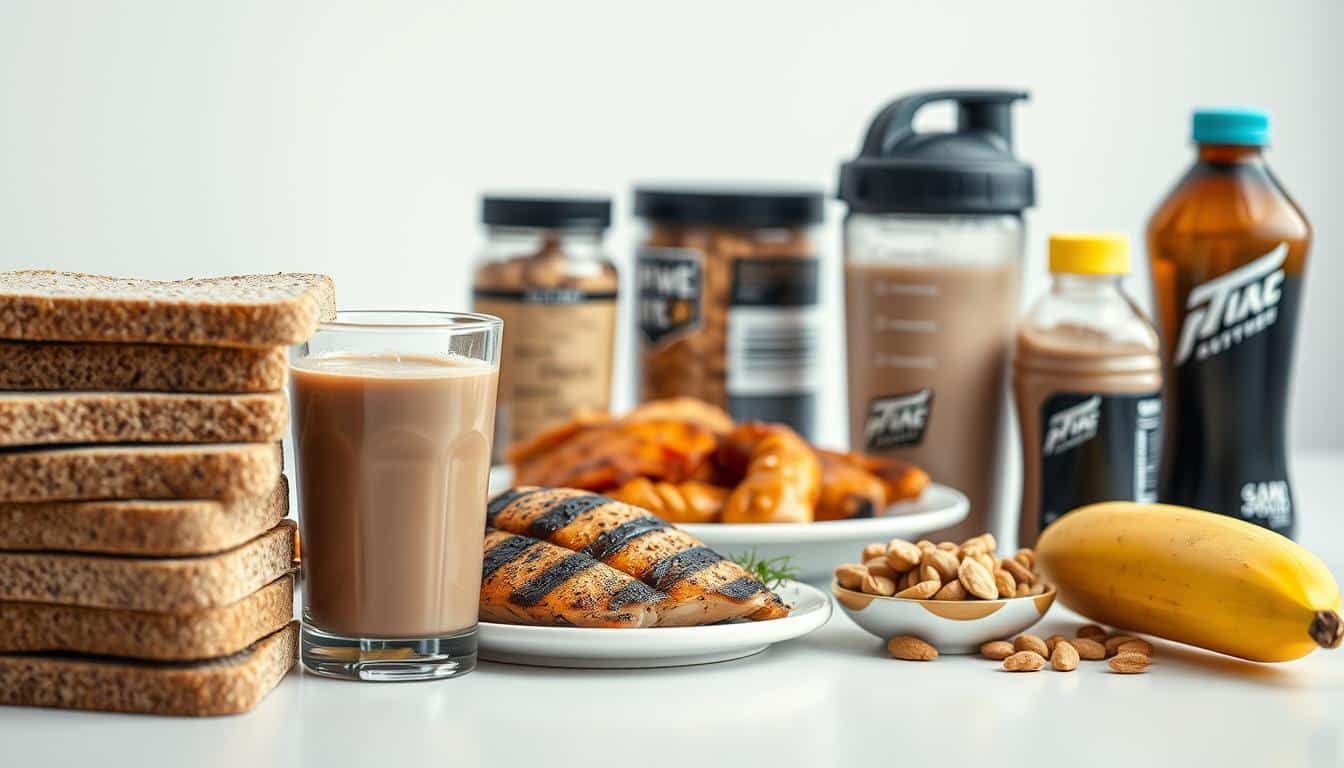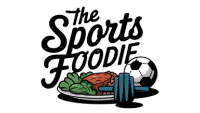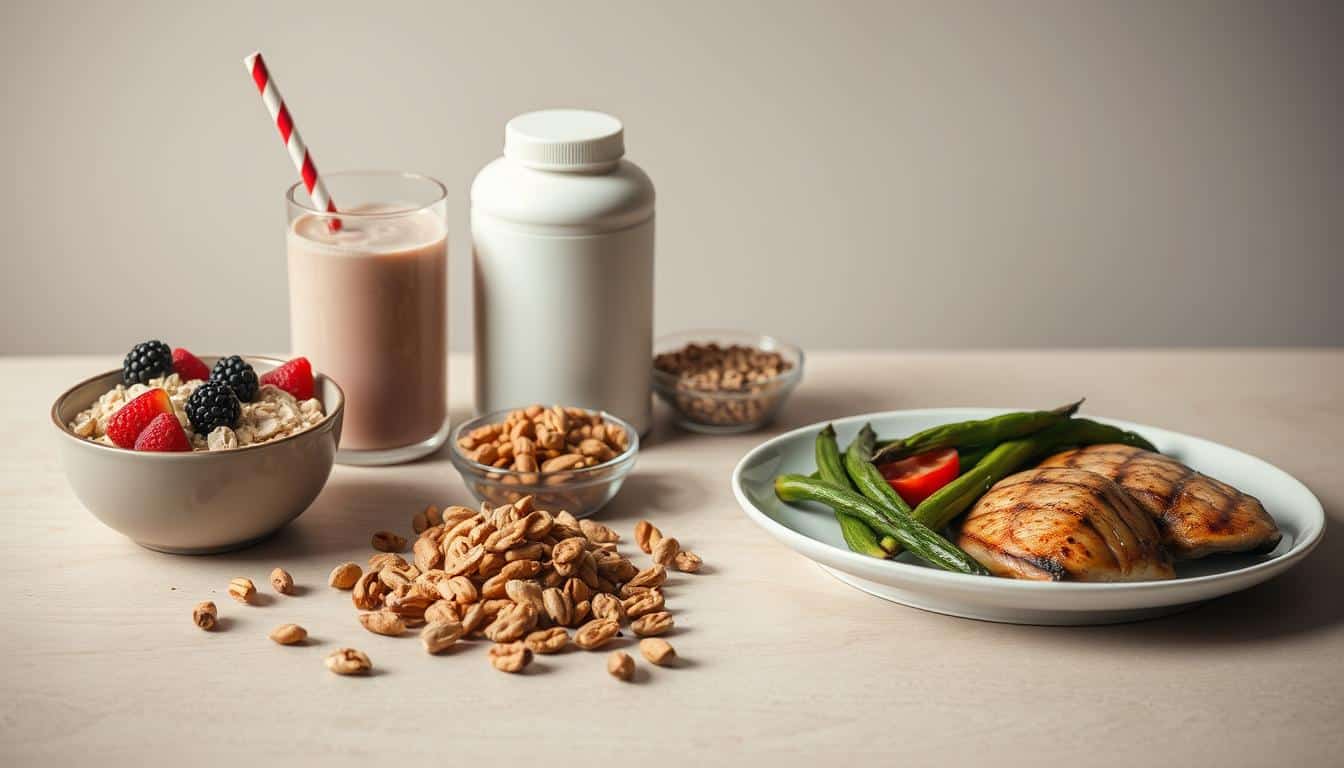You’ve just crushed a tough training session, but are you fueling your body the right way to maximize results? If progress feels slower than expected, the missing piece might be your nutrition timing—specifically, the balance between carbohydrates and protein.
During exercise, your muscles burn through stored energy called glycogen. Without proper replenishment, you’ll struggle to recover fully or build strength efficiently. Weight training also creates microscopic muscle tears that require specific nutrients to repair and grow stronger.
This is where your post-training meal becomes critical. Research shows combining fast-digesting carbs with quality protein accelerates recovery. While recommendations vary slightly, most experts suggest ratios between 2:1 and 3:1 carbohydrates to protein—think 40-70g carbs and 20-30g protein for most active adults.
We’ll simplify the science so you can create meals that support muscle growth, reduce soreness, and prepare you for your next session. No complicated math or guesswork—just clear strategies to make every workout count.
Introduction to Post-Workout Nutrition
Have you ever wondered why some people bounce back faster after intense sessions? The answer lies in understanding how your body uses nutrients during recovery. When you lift weights or push through cardio, two critical processes occur: energy depletion and muscle stress.

During physical activity, your muscles burn stored carbohydrates (glycogen) as primary fuel. This leaves your energy reserves low. Simultaneously, resistance training creates tiny tears in muscle fibers – a natural part of building strength. Without proper nourishment, your system struggles to repair these micro-damages effectively.
The first 60 minutes after exercise offers a unique opportunity. Your body becomes primed to absorb nutrients that:
| Process | During Exercise | After Fueling |
|---|---|---|
| Energy Levels | Glycogen depleted | Rapid replenishment |
| Muscle State | Micro-tears present | Repair initiated |
| Nutrient Focus | Breakdown dominant | Rebuilding optimized |
Smart eating during this window does more than satisfy hunger. It shifts your physiology from breakdown mode to growth mode. For those seeking deeper insights, our guide on proper nutrition explains how these principles apply across all training types.
Remember: recovery isn’t passive. By choosing foods that address both energy restoration and tissue repair, you’ll maximize every sweat session. Your next workout performance depends on what you do right now.
Benefits of Proper Carb and Protein Intake
What happens when you give your body the right nutrients after pushing your limits? The right mix of macronutrients acts like a recovery power duo. Let’s break down how this partnership works.
Muscle Repair and Growth
Protein delivers amino acids – the raw materials your muscles need to rebuild. After intense activity, these building blocks patch up microscopic tears, making tissues stronger than before. Without enough, progress stalls.

Carbohydrates play a supporting role here. They provide immediate fuel so amino acids can focus on repair instead of being burned for energy. This teamwork helps you maintain – and even increase – lean mass over time.
Energy Replenishment and Glycogen Restoration
Your muscles aren’t just hungry for protein. They crave quick energy restocking too. Carbohydrates refill glycogen stores – your body’s preferred energy source during high-intensity efforts. Think of it like charging a battery between uses.
Here’s why timing matters:
Consuming these nutrients together spikes insulin levels naturally. This hormone shuttle drives glycogen into muscles and amino acids into cells simultaneously. The result? Faster recovery and better readiness for your next challenge.
Understanding Your post workout carb to protein ratio
Timing isn’t just about when you eat—it’s about how quickly your body can use what you consume. Research shows a 3:1 balance of energy sources to muscle-building components works best for most people. For example, someone weighing 70kg (154lbs) would aim for roughly 70g of quick-fuel foods paired with 23g of rapid-absorbing muscle support.
Speed Matters for Nutrient Delivery
Immediately after training, your muscles act like sponges. Fast-acting energy sources like glucose or dextrose flood depleted cells with glycogen. Pair these with quickly absorbed options like whey protein isolate—it enters your bloodstream 50% faster than other forms.
Save slower-digesting meals like oats or casein protein for later. These provide sustained nourishment 1-2 hours post-session when immediate repair needs are met.
How Energy and Building Blocks Team Up
Carbohydrates do more than refuel—they create an insulin spike that drives amino acids into muscle cells. This partnership lets proteins focus on repair instead of being burned for energy. Together, they:
- Restore glycogen stores 40% faster than carbs alone
- Reduce muscle breakdown by 33% compared to protein-only intake
Keep fats low during this critical window. Even healthy fats like avocado can slow absorption by up to 25%, delaying recovery benefits.
Timing and Meal Planning for Effective Recovery
Ever notice how some athletes seem ready to train again faster? The secret lies in syncing your meals with your body’s recovery rhythm. Your muscles absorb nutrients best during specific windows – miss them, and progress slows.
Utilizing the Window of Opportunity
Your muscles become supercharged nutrient sponges within 30 minutes of finishing exercise. Studies show consuming a liquid shake during this period delivers amino acids 40% faster than solid food. This quick action helps:
- Replenish energy stores before they’re fully depleted
- Kickstart muscle repair while inflammation is lowest
- Reduce next-day soreness by up to 28%
After this initial rush, your system stays receptive for two hours. Plan a whole-food meal during this phase – think grilled chicken with sweet potatoes. This combo provides sustained nourishment as recovery continues.
Pre- and Post-Training Meal Timing
Effective fueling starts before you begin. Eating a banana or rice cake 45-60 minutes pre-session gives steady energy without stomach discomfort. Post-activity nutrition follows a two-phase approach:
| Time Frame | Goal | Food Type |
|---|---|---|
| 0-30 minutes | Rapid absorption | Whey protein + fruit juice |
| 1-2 hours | Sustained repair | Lean meat + complex carbs |
Consistency matters most. Pack your gym bag with prepared shakes or snacks to avoid missing these critical windows. Your body thrives on routine – regular meal timing trains your metabolism to optimize every bite.
Practical Meal and Shake Ideas for Training Recovery
Fueling your body doesn’t require gourmet meals—just smart combinations that deliver results. Whether you prefer liquid nutrition or whole foods, these options help muscles rebuild while restoring energy.
Quick Liquid Recovery Options
Liquid choices shine when speed matters most. They bypass lengthy digestion, getting nutrients where they’re needed fast. Try these:
| Drink | Ingredients | Benefits |
|---|---|---|
| Rapid Shake | Whey protein + dextrose + water | Ready in 60 seconds, 25g protein |
| Chocolate Milk | Low-fat milk + cocoa | Natural 3:1 carb-protein balance |
| Electrolyte Mix | Sports drink + pinch of salt | Replaces minerals lost through sweat |
Solid Food Meal Examples
When you have more time, whole foods provide lasting nourishment. These meals combine taste with science-backed ratios:
| Meal | Components | Macronutrients |
|---|---|---|
| Power Burrito | Eggs, black beans, whole wheat tortilla | 31g protein, 49g carbs |
| Chicken Plate | Grilled breast, sweet potato, greens | 26g protein, 40g carbs |
| Yogurt Bowl | Greek yogurt, berries, oats | 20g protein, 35g carbs |
Prep these options in advance for grab-and-go convenience. Endurance athletes training over 60 minutes should add electrolyte drinks to their routine—they prevent cramping better than plain water.
Conclusion
The right fuel combination after exercise transforms how your body bounces back. Aim for three parts quick carbs to one part quality protein within 30 minutes – a chocolate milk or whey shake works perfectly. This timing helps restore energy stores while jumpstarting muscle repair.
Follow your liquid intake with solid foods 1-2 hours later. Grilled chicken with rice or a yogurt bowl keeps the recovery process active. Remember, your weight determines exact amounts – heavier athletes need slightly larger portions.
Hydration fuels every part of this process. Drink water before, during, and after activity to help nutrients flow where they’re needed. For those needing structure, our 7-day meal plan offers balanced options that fit busy schedules.
Consistency beats perfection. Pack your gym bag with ready-made shakes or snacks so you’re never caught empty-handed. When you pair smart nutrition with hard training, you’ll notice stronger performance, faster recovery, and lasting results.


